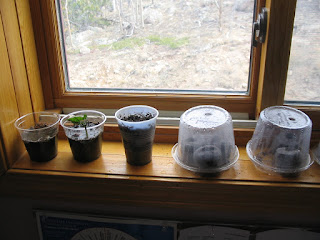About this time every year, I start hearing folks say that they already started seeds for their vegetable transplants. As if it is a competition, the dates seem to get earlier and earlier each year. While it is none of my business who starts their seeds when, I always take the opportunity to address my concerns of starting too early when I hear about these early start dates.
While you may never truly be safe planting warm season vegetables in mountain communities, it is typically recommended that no warm season plants should go in the ground in my community before the first week of June. To find average frost dates for your area, check the dates here.
Now of course, this completely depends on your gardening style, and the season extension tools you may utilize in your endeavor to be the only one in the county with tomatoes. Season extension aside, let’s look a little more closely into using transplants and some of the difficulties you face growing your own vegetable transplants are home.
The most important thing to avoid is what is called transplant shock. Transplant shock occurs when plants undergo various environmental stresses. These stresses include root damage, temperature extremes, or strong winds. Plants subjected to transplant shock are often stunted or delayed meaning you could lose some of your early seeding advantage.
To avoid transplant shock, the first thing to identify is what prefers to be transplanted versus direct seeded? Some plants like curcubits (melons, cucumbers, summer squash) don’t like having their roots damaged or disturbed, so proper care needs to be taken when planting such varieties. Solutions such as peat pots that can be directly planted into the soil can be a good solution. Other vegetables, due to their longer growing season requirements have to be transplanted or you won’t get a crop before that pesky fall frost returns. A general rule of thumb is to start transplants 4 - 6 weeks prior to the last frost. Check this link for more specific details on starting plants from seed. The biggest difference between your transplant seeding dates for vegetables is going to be the crops cold hardiness. Some cool season crops like brassicas (broccoli, kale, cauliflower) will tolerate much cooler temperatures than warm season vegetables like peppers, tomatoes or eggplant. To learn more about the hardiness of vegetables click here.
 Growing vegetable transplants inside 4 - 6 weeks prior to planting means you need supplies or tools that will grow sturdy and strong transplants not tall, spindly ones. Most vegetable varieties will not grow to be healthy transplants just sitting in a sunny window, so if you are gonna invest the time, make sure you have the tools. Supplies needed include a heat mat to keep the roots at a consistent temperature, a humidity dome to maintain heat and moisture, trays that retain water but don’t drown the plants, a fertility program, and grow lights.
Growing vegetable transplants inside 4 - 6 weeks prior to planting means you need supplies or tools that will grow sturdy and strong transplants not tall, spindly ones. Most vegetable varieties will not grow to be healthy transplants just sitting in a sunny window, so if you are gonna invest the time, make sure you have the tools. Supplies needed include a heat mat to keep the roots at a consistent temperature, a humidity dome to maintain heat and moisture, trays that retain water but don’t drown the plants, a fertility program, and grow lights.If you don’t have the equipment, or aren’t willing to invest in it, look for local growers who do. In my area, we are fortunate to have several vegetable farmers who take great pride in producing vegetable transplants. For many of them, the early season sales help to offset the high upfront costs vegetable farmers incur at the beginning of the season.
Remember, transplant shock can take away any added benefit of starting plants early, so invest in the proper equipment or invest in a quality product where someone already has.
Happy Gardening….


No comments